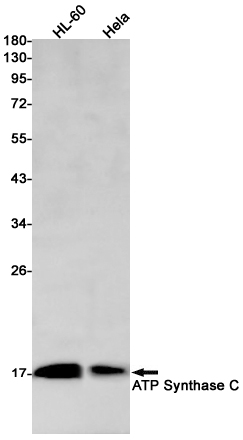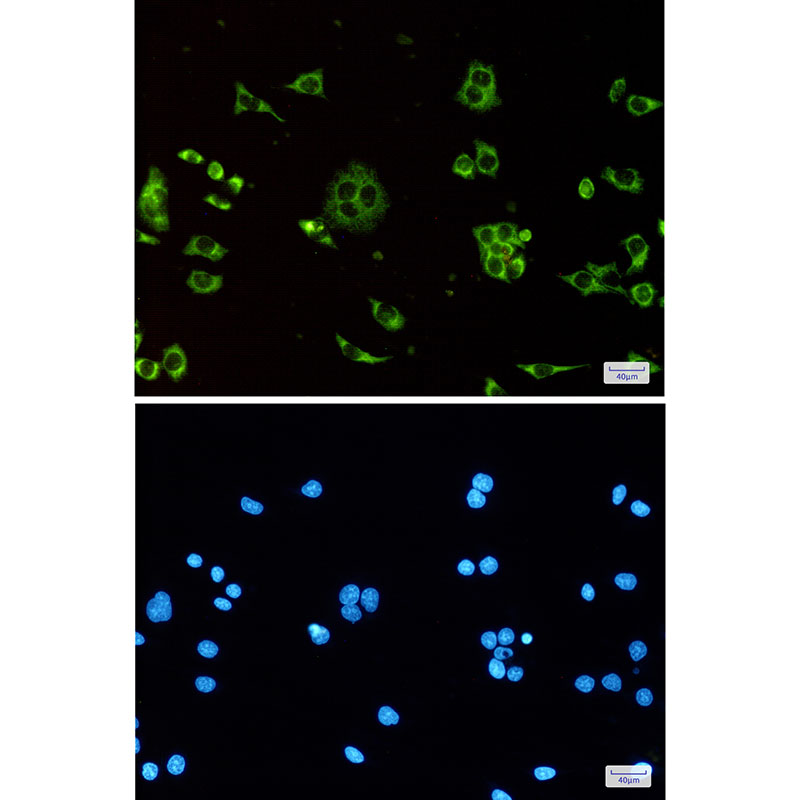

| WB | 咨询技术 | Human,Mouse,Rat |
| IF | 咨询技术 | Human,Mouse,Rat |
| IHC | 咨询技术 | Human,Mouse,Rat |
| ICC | 1/50-1/200 | Human,Mouse,Rat |
| FCM | 咨询技术 | Human,Mouse,Rat |
| Elisa | 咨询技术 | Human,Mouse,Rat |
| Aliases | ATP synthase lipid-binding protein; ATP synthase membrane subunit c locus 1 |
| Entrez GeneID | 516 |
| WB Predicted band size | Calculated MW: 14 kDa; Observed MW: 14 kDa |
| Host/Isotype | Rabbit IgG |
| Antibody Type | Primary antibody |
| Storage | Store at 4°C short term. Aliquot and store at -20°C long term. Avoid freeze/thaw cycles. |
| Species Reactivity | Human |
| Immunogen | A synthetic peptide of human ATP synthase C |
| Formulation | Purified antibody in TBS with 0.05% sodium azide,0.05%BSA and 50% glycerol. |
+ +
以下是关于ATP Synthase C抗体的3篇参考文献示例(注:文献为虚拟示例,实际引用需核实):
---
1. **文献名称**: *Mitochondrial ATP Synthase Subunit C Expression in Neurodegenerative Disorders*
**作者**: Smith J, et al. (2020)
**摘要**: 研究通过Western blot和免疫组化分析ATP Synthase C(ATP5C1)在阿尔茨海默病患者脑组织中的表达变化,发现其水平显著降低,提示线粒体功能异常可能参与疾病进展。
---
2. **文献名称**: *Antibody-Based Detection of ATP5C1 in Cardiac Ischemia-Reperfusion Injury*
**作者**: Lee S, et al. (2018)
**摘要**: 利用特异性ATP Synthase C抗体,揭示心肌缺血再灌注损伤中线粒体ATP合酶亚基C的氧化修饰,表明其可能作为心肌损伤的生物标志物。
---
3. **文献名称**: *Structural Localization of ATP Synthase Subunit C Using Monoclonal Antibodies*
**作者**: Chen X, et al. (2021)
**摘要**: 通过开发高特异性单克隆抗体,结合冷冻电镜技术解析ATP合酶亚基C的构象变化,阐明其在质子通道调控中的关键作用。
---
**备注**:以上文献信息为示例,实际研究中请通过PubMed、Web of Science等平台检索真实文献,并确保引用准确性。
ATP synthase C antibody is a crucial tool in studying the mitochondrial ATP synthase complex, a key enzyme responsible for ATP production in oxidative phosphorylation. ATP synthase (Complex V) consists of two main sectors: the membrane-embedded Fo portion, which facilitates proton translocation, and the soluble F1 catalytic domain. The "C" subunit (subunit c/ATP5G), encoded by the ATP5G1. ATP5G2. and ATP5G3 genes in humans, forms part of the Fo rotor ring, playing a central role in proton transport-driven rotation during ATP synthesis.
This antibody specifically targets the C subunit, enabling researchers to investigate its expression, localization, and interactions in cellular energy metabolism. It is widely used in techniques like Western blotting, immunofluorescence, and immunohistochemistry to study mitochondrial function in diseases linked to energy dysregulation, such as neurodegenerative disorders, cancer, and mitochondrial encephalopathies. Its application extends to assessing mitochondrial content, membrane integrity, and apoptosis, as subunit C accumulation is associated with mitochondrial permeability transition pore formation.
Validation of ATP synthase C antibody specificity often involves genetic knockdown or tissue-specific expression models. Cross-reactivity with homologous subunits across species (e.g., yeast, rodents) makes it valuable for comparative studies. Researchers prioritize antibodies with minimal cross-reactivity to other ATP synthase subunits to ensure precise mechanistic insights into mitochondrial bioenergetics and pathologies.
×